Imagine this scene from Raton’s past: Saturday night, sometime in the early 1950s. A tide of miners, ranchers, race trackers, and theater-goers swelled the downtown streets. The white noise whoosh of traffic moved along Raton’s main drag. Second Street was alive with the revving engines and blaring horns of motorists, and at times the roaring sound of a motorcycle engine accelerating. Somewhere in the distance, the full-throttled growl of a truck could be heard, along with muffled music pulsing from car radios. In the midst of all the brisk traffic stood Richard (Dick) Bonahoom, Raton’s Chief of Police, directing the comings and goings, much like a conductor guiding an orchestra. Appearing suddenly without warning a fancy black Cadillac limo roared through the town at top speed, easily charging through a red light as it headed south. The car was brought to a halt with a shrill high-pitched “FWEET”, as Chief Bonahoom used his whistle to corner the offending driver. With an exaggerated sense of importance, the driver inquired, “Do you know who I have in the back seat?” Undaunted, Chief Bonahoom answered back, “I don’t care who you have in the back seat. You ran a light. Here’s your ticket.” Duly penalized the driver tooled on down the road. About a week later, the Chief accepted delivery of an official looking envelope from Santa Fe. As it turned out, the passenger in the ticketed limo was none other than New Mexico’s Governor, Edwin Mechem! Governor Mechem sent along a commendation and a personal note of thanks to the Chief. The governor was favorably impressed with the Chief’s refusal to show preferential treatment to a VIP – in favor of enforcing the law!
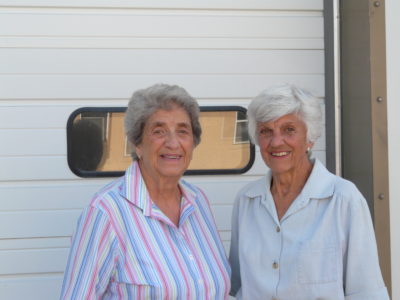
This classic anecdote testifies to the integrity of Chief Bonahoom and validates his place as a standout in the annals of Raton’s history. Ratonians Diana (Bonahoom) Best and Barbara Bonahoom, daughters of the former chief, can easily delve into their treasure trove of memories and come up with dozens of similar, fact-based stories about their legendary father.
The Backstory
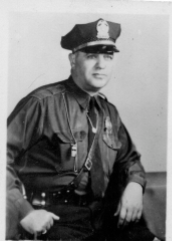
Proud of his heritage, Richard Joseph Bonahoom represented the second generation of a Lebanese family who migrated to the United States in the early 1900s. Initially, the Bonahoom family, including Richard’s parents, Charles and Rose, as well as Charles’s brother Murphy and his two sisters, Selema and Zahiah settled in Springfield, Illinois. Richard was born in Springfield on October 20, 1904, and when he was about four years old, the family moved west, staying for a while in Aguilar, Colorado, and finally moving on to Raton. Charles and Rose prospered as merchants, operating a general store known as Bonahoom Brothers’ Mercantile, at 127 Martinez Street in east Raton. The Bonahooms also homesteaded a ranch about eleven miles southeast of Raton, where Charles broke horses.
Richard acquired his general education in Raton’s public schools, worked in the store and at the family ranch for a while, then entered the labor force. He tried several jobs, including painting cars and pumping gas, before taking a position as a patrolman for the city of Raton. After a few years, he resigned to accept an assignment as a Special Officer of the Santa Fe Railroad, followed by an eighteen month stint at the Pan Tex Ordinance Plant in Amarillo, Texas, before coming back to Raton to do the job he was destined for. He accepted the position of Chief of Police for the city of Raton in late 1939 and continued with his life’s work until his untimely passing in 1966. The length of his tenure as Chief – twenty-seven and a half years – set a record in New Mexico’s history, and it is the view of Barbara and Diana that the record continues to be unparalleled.

Richard Bonahoom married his childhood sweetheart Emily Haddad of Vancouver, British Columbia on July 16, 1938. When he accepted the Chief’s job, Diana was a baby and Barbara was but a twinkle in her father’s eye. An apartment, adjacent to police headquarters and the jail, and next door to the fire department, was the family residence. Barbara recalls a small peccadillo on her part while growing up “at the jail”: “To this day you can see it on the fire station building. I was small and I took a file and I filed the corners of the building as high as I could go. I went to every corner, filed them all the way up, went across to the next one. It’s still there. And yes I got into trouble!” “That whole block was our playground,” Diana notes, “the St. Louis Rocky Mountain and Pacific Company had their offices across the alley and they had a parking lot and they had that patch of grass that’s still there, but it’s fenced in now. That’s where we used to play. We’d skate around the block and we weren’t afraid. Everybody on that block knew who we were. There wasn’t any danger.”
Living the law enforcement lifestyle, Chief Bonahoom, required that his family be held to a higher standard than most, but in a positive way. Diana remembers, “It was always told to me by my mother, ‘You have to set an example so I always felt that I couldn’t do some of the things the other kids were doing. I was always hesitant because I had to set an example.” Barbara says, “I think too…like dating in high school, the boys were afraid to ask us out because our dad knew more about them than they wanted him to!”
No Favorites!
Holding a position of trust in the community, the Chief complied with high standards of conduct – that he set for himself. Barbara says of her father, “He was fair to everybody. He was respectful to everybody. He was stern, but understanding. There were no favorites; everybody was equal. If a family member broke the law, he got them. Everybody loved him. You hear stories today of those who knew him and it’s just like he’s living today. His integrity was unbelievable and he was very trustworthy.”
Diana learned early on that she wasn’t going to be the receiver of any special treatment from her dad. She remembers the time when she was applying for her driver’s license: “I took the written test for my driver’s license, passed it, no problems. I was ready for the driving test, so my dad said, ‘All right who do you want to take you out for your driver’s test, Tony (Bonomelli) or me? So I thought, well this is a snap, my dad of course! Big mistake! He had me parallel park and to this day I hate to parallel park. In those days the 1936 Oldsmobile we were driving had a stick shift on the floor. He made me come up the north underpass, stop at the top of the hill, turn the car off, restart it and go (forward) without rolling back. He didn’t do that with the other kids.”
The Chief’s wife wasn’t spared from the long arm of the law either. Soon after the city of Raton had installed traffic control signals, she was caught jaywalking near the 100 block of South Second Street. Diana tells the story: “Mom was in the house. She wanted to go downtown and Dad was in the office. So she came out of the house through the office door. She knew he was in there. She walked down the alley, went up to South Second Street and she jaywalked. He caught her. In the middle of the street, he grabbed her by the ear lobe. He said, ‘You get back on that curb.’ Still holding on to her ear lobe, he walked her back on the curb. He said, ‘You’re no different from anybody else. You cannot jaywalk.’ She never forgave him for that!”
He didn’t play favorites and he didn’t want special treatment of any kind, no special perks like extra time off or a designated parking spot for his car. One example is recalled by Barbara. “We parked the family car in front of the jail. When Diana started driving, sometimes she would come home and somebody else had parked there. So she and one of the firemen, Bert Wills, got an idea to paint the curb for that parking area and put Chief’s Car Only. She got in trouble! My dad didn’t want anything special to stand out like that because he was a city official. So both of them had to go back and repaint that curb.”
The chief’s personal code of conduct was tempered by a sense of compassion. Many times he provided a cell (doors open) and meals paid for out of his own pocket to those living rough and in need of food and shelter. Once on his early morning rounds, on a particularly icy cold morning, he discovered a problem drinker face down in a frozen puddle of water. He worked the man free, took him to the jail, warmed him up with a shot of whiskey, and helped him to get sober. Then there was Minnie Lake, dubbed “Minnie the Moocher”, a sort of 1960s era dumpster-diver, who roamed the city streets clad in bib overalls and pulling a red wagon. Barbara remembers, “If she got in trouble or she needed something she always called our dad. Always. When she was in the hospital, he took her and he picked her up, but before he picked her up, he went to her house and lit a fire in her stove, and filled her refrigerator with groceries. Then he went and got her and brought her home.” Minnie was oftentimes subjected to mockery and teasing from others in the town, but she was treated with consideration by the Chief and his family. “We respected her because our dad respected her,” says Barbara, “We were just taught that.”
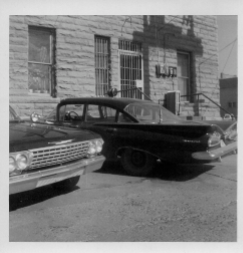
The Raton Police Department: Then and Now
Chief Bonahoom started fighting crime in Raton during a socially and morally conservative era, a time when strong family units, regular churchgoing, manners, and respect for others were the norm, rather than the exception. A scrapbook kept by the Chief, of news articles culled from The Raton Daily Range and other newspapers of the time indicate that the chief and his fellow officers had plenty of crime to deal with – domestic violence, drugs, gambling, alcoholism, and even murder – but perhaps not to the extent of what today’s police officers face. Diana says, “It was a much tamer time in the 1940s and 1950s. We had crime but it wasn’t vicious and violent like it is now.” Barbara adds, “We had drugs, we had domestic violence, but not as bad as today. So I think the problems have multiplied.”
Chief Bonahoom did not have formal training for police work but gained his knowledge and savvy on the job, plus he commanded an exceptional understanding of his community and its residents. According to Barbara, numerous personal contacts with Raton’s citizens built up his personal bank of knowledge, enabling him to quickly identify a car or a person involved in a crime or accident. She says, “What stood out about him was that he knew everybody’s name, he knew what cars they drove, he knew where they lived. He walked the beat. He didn’t sit in an office all day. He was out on the road; he was walking.”
In the early days, the Raton Police Department, comprised of the Chief and five officers, worked to reduce crime with a minimum of equipment: guns, nightsticks, and handcuffs. The police office adjoined the fire department. “At that time the police office wasn’t a whole building of twenty-five offices. It was one big room – on one side was a desk for police work, on the other side of the room was a desk for the municipal judge. Sometime in the early 1960s a counter was built running the full length of the wall, so they could stand behind the counter and work,” says Barbara. She continues, “The first dispatchers were our mother (Emily), Diana, and myself. We were the first ones to be the dispatchers on the police radio.” The local office was also used by the FBI. They used it as their home office while conducting business in the area. The early police office was later torn down and nowadays that area is an extension of the fire department, a garage for the fire department’s vehicles.
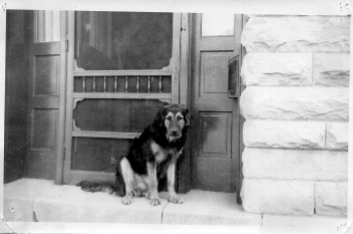
Chief Bonahoom’s dog Count, a Shepard mix, was the department’s first police dog. “Count used to go with him everywhere,” says Barbara, “but not in the car. He would run alongside the car.” Count was known for literally “taking a bite out of crime”! Apparently, he developed an aversion to perpetrators in an inebriated state and had his own way of dealing with them. Barbara recalls that Count could easily put a rowdy tippler in line by biting him in the seat of the pants! The imbiber would gladly put himself in a cell to avoid the dog’s sharp teeth!
Initially, the men on the force used their own cars while tackling crime. It wasn’t until 1952 that the city purchased two brand new cars from United Chevrolet Company for the police department. Throughout the almost three decades that Dick Bonahoom was Chief, the city owned only two official police cars, changing them out about every three years. Although the Chief had access to the city-owned cars, he often preferred to use the family car, a black Hudson fitted out with a siren and floodlights, while patrolling on the job. The town’s youth, keenly aware that the presence of the Hudson signaled that the Chief was keeping watch on them, christened the vehicle Black Maria (Moe rye uh).
Fast forward to 2021: As stated by the current Police Chief, John Garcia, today’s Raton Police Department has upgraded to a force of nine officers, including one female officer, and a fleet of eleven operational vehicles. The department also boasts six dispatchers, one full time animal control officer, one part time animal control officer, and a records clerk. Each officer is outfitted with 25 to 35 pounds of equipment, including a bullet resistant vest, gun, taser, OC (Oleoresin Capsicum) spray, handcuffs, baton, radio, and body camera, ensconced in a duty belt with holsters. Initially, a rookie officer takes part in field training at the police department, then within a year’s time fulfills a requirement of four months at the police academy. Requirements for the K-9 Unit, aka Count’s successors, are three months of continuous training for the dog and handler and quarterly training and certification thereafter.
While on duty, Chief Bonahoom always carried a gun, usually a Colt revolver caliber .45 LC. He carried a rifle during roadblocks. Although he was an expert marksman, as stated by Barbara, “he never had to pull his gun and he never had a gun pulled on him”. During his extended term as Chief, he used his gun only once. An article in the Chief’s scrapbook delineated the circumstances. A truck driver, D.E. Corey, was getting his truck ready for a trip and checking his tire pressures at the One-Stop Service Station, across the avenue from police headquarters. The Raton Daily Range wrote, “As he started to inflate an inside tire on the rear dual wheels, the rim lock ‘blew out’ jamming the two tires together, and trapping Corey’s hand”. The chief was called and “pumped four shells from his pistol through the 16-ply tire to burst it”, releasing the driver from his “agonizing prison”.
Like father, like daughter, Barbara began honing her shooting skills at an early age. It all started with a mouse and a BB gun. Fairly often, on Fridays, the FBI would use the police office to conduct business. On a particular Friday, when Barbara was about nine years old, she was sitting on the steps leading up to the office, idly listening, when she noticed a mouse under a radiator across the room. She relates what happened. “Without saying anything I went upstairs and I got my BB gun and I came back and sat on that step and I waited and waited for that mouse just to show his head. And I killed him. I shot him. They (the FBI guys) were soooo impressed.” She goes on to say, “From then on, whenever they came to town, they brought me a box of shells so that we could go shooting on the weekend.” As it turns out, Barbara competed against the FBI, the sheriff, and the state police on a fairly regular basis. One of her favorite shooting memories involved a shotgun that had been used in a robbery. The confiscated gun, a 12-gauge pump gun, was sawed down to a 16-inch barrel. “I shot that gun. Dad let me shoot it,’ she says, “and I had a bruise, but oh was it fun. I mean it was fun. What an experience! I wouldn’t trade it for the world – growing up at the jail!”
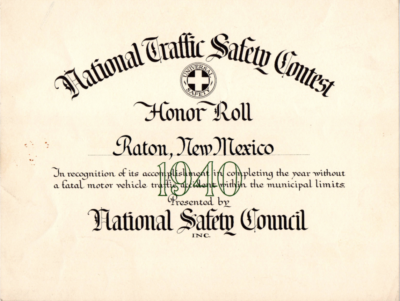
Being Safe and Preventing Danger
Traffic safety was a top priority for Chief Bonahoom. When Saturday night rolled around in Raton, like as not the Chief would be seen brandishing his whistle while directing the traffic on busy Second Street, for he worked the rotation the same as his officers. The Chief was ever vigilant about making the streets safer for pedestrians and motorists alike, conducting anti-jaywalking campaigns, and working towards enforcing the city’s traffic ordinances. At one point he took out an ad in the local newspaper, announcing that the police department would not tolerate violations of the city’s traffic laws. His mantra was “Let’s make Raton safety conscious!” The efforts of the Chief and his force paid off: most importantly, lives were saved, but the city also received kudos from the National Safety Council. For two years in succession, 1940 and 1941, Raton was awarded a Scroll of Honor by the National Safety Council for having no fatal traffic accidents inside the city limits. In 1941 Raton was the only city in New Mexico to earn that honor. Commenting on the safety award in The Raton Daily Range, Mayor J.R. Kastler praised the city police force “for being always on the job”.
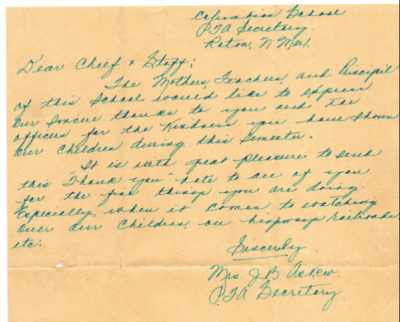
Safety of the town’s children was especially important to the Chief. During the school months, the Chief and Count or Officer Tony Bonomelli were on the job at the Columbian Elementary school crossing. Three times a day, early morning, lunchtime, and after school, the school crossing sign was rolled out in the middle of Second Street (U.S. Highway 85), near the corner of Moulton Avenue, as the Columbian kids carefully negotiated crossing the Santa Fe railroad tracks and the busy through the street. The school crossing sign was easy to spot. It was a heavy tin figure of a policeman with his hand on top of a tire rim. Barbara says that Count would curl himself around the sign and go into snooze mode until he heard the lighthearted chatter of approaching children. Immediately he was on the job, escorting the youngsters across the street.
Gratitude for the protection of young lives is expressed in several pages of the Chief’s scrapbook, via thank-you notes and letters from parents, teachers, and organizations such as the PTA. Reporter James Barber in his column NEWS VIEWS, The Raton Daily Range, described a heartwarming story. As the story goes, a young boy knocked on the door of the police station, handed over a package and note, and quickly ran away. The package contained a box of cigars and several packages of cigarettes. The note, adorned with an illustrated bouquet of flowers, read as follows:
 “To Chief Bonahoom and his boys
“To Chief Bonahoom and his boys
The police force always gets plenty of knocks and criticisms but not many bouquets – so here’s one they really deserve. The job you have done at Moulton and Second for the kids crossing the highway and tracks has been deeply appreciated. Maybe in your ‘line’ but not mandatory and surely inconvenient as to time and weather and the kids talk more about the cops than they do Santa Claus. So just have a smoke on the kids. And they say give the fire chief and the boys a smoke too.”
The note and gift were unsigned but the Chief surmised that the gift-givers were more than likely the sixty-five kids who crossed the Santa Fe Railroad tracks and Highway 85 at Moulton Avenue every day.
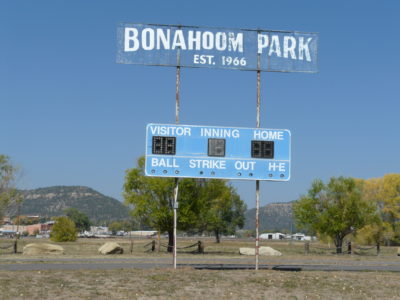
The Legendary Chief
Soon after the Chief’s death, the action was taken by the Raton Jaycees to dedicate a combination rodeo arena and softball park in his memory. Upon completion of Bonahoom Park, next door to Longfellow Elementary School, a dedication ceremony was held with the Chief’s widow Emily throwing out the first ball. After the ceremony, the new park was suitably initiated with a calf roping contest and a softball game. Successful professional rodeos were held in the park over a number of years, leading to the construction of a huge grandstand capable of seating 1200 people. The rodeo expanded and actually outgrew the space, eventually moving to a larger area southwest of town. Bonahoom Park now functions solely as a softball field.
In October 2015 a Plaque Dedication Ceremony, set in motion by Officer John Valdez of the Raton Police Department, was held at the park to honor the former Chief. The plaque, which recognizes the Chief’s commitment and service to the city of Raton, was installed behind home plate.
Chief Richard J. Bonahoom left behind an unforgettable impression on the city of Raton. Almost anyone over the age of sixty, now living in Raton, has a story to tell about him. He’s fondly remembered. He touched lives of all ages and standards of living. He was well-loved and respected.
The Chief wore a gun and was an expert marksman, but basically spurned sidearms in his work as a police officer. He wanted the local populace to respect the badge he wore and the law he represented rather than the gun on his hip. His common sense approach to law enforcement earned Raton the reputation of having one of the best records for crime prevention in New Mexico. His daughter Barbara says of her father: “There will never be another one like him. I don’t care how hard anyone tries to beat his reputation they will never do it! Never! Because he was one that people trusted; they loved him and they could always go to him if they needed help and he would help them.”
- A BIG THANK YOU to Diana Bonahoom Best and Barbara Bonahoom for the use of vintage documents and photos and the Chief’s scrapbook
- SPECIAL THANKS to Linde Schuster, member of the Raton City Commission and Mayor Pro Tem, for her assistance in gathering information for this article
- HATS OFF to the RATON POLICE DEPARTMENT for serving and protecting Raton’s citizens and defending our town from criminal activity! THANK YOU!

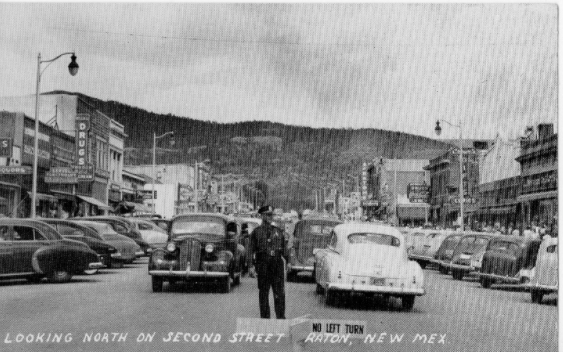
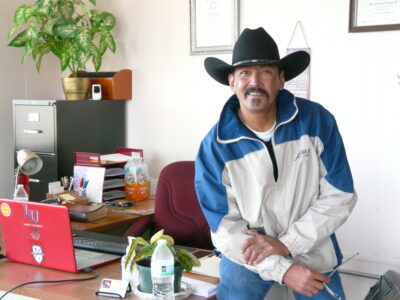
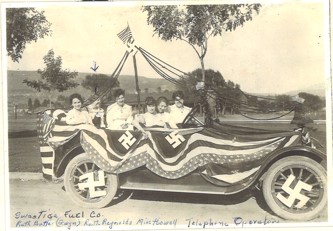


What a great story about chief Bonahoom!! He definitely was a legend in our town.
This is a terrific website for Raton and New Mexico. Thank you, Pat. Your work is extremely good and you are a very talented writer.